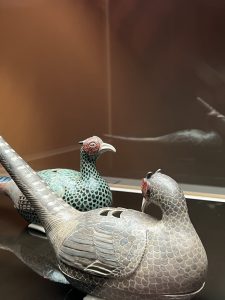香炉の自由さがいつもきになります。(愛知県名古屋市千種区姫池通 骨董買取 古美術風光舎)
2024.04.02
みなさまこんにちは、スタッフYでございます。

古美術風光舎ご近所界隈の桜の開花状況が気になり、先ほど山崎川の桜をパトロールして参りました。結論。三分咲き。ちらほら花は咲いていたのですが、わーっと高揚するような満開まではもう少しといったところでありました。
まだお花見の方というかはご近所の方がお散歩やジョギングなどで通り過ぎているといった状況でしたが、咲き始めた桜を静かに眺めることはできましたので、その点は良かったと思います。満開になりましたら、またレポートいたしますね。
さてさて、本日はちょっと気になっている「香炉」の世界についてです。
店内にもいくつか香炉があるのですが、個人的には好きな骨董品。お国柄、宗派、素材になどなど、とてもバリエーションが多くしかもユニークだからでしょうか。
「香炉」は、お香を焚くために使う器のことなのですが、仏壇にお祀(まつ)りする仏具の中でも最も大切なもののひとつなのですが、宗派や地域の風習によって使用する香炉に違いがあり、用途も若干の違いがあります。また、仏具から香道や部屋の調度品などにも用いられるようになり、材質は陶磁器や金属製、漆器など様々。
そもそも香炉も香も発祥の地は、ご存じの通り日本ではなく海外からなのですが、仏教起源の地である古代インドには、一年を通して気温が高く、スパイス文化が発達したインドでは、悪臭を防ぐためにさまざまな香料をブレンドしたお香を体にまとう風習があったとされております。
その文化がギリシャやエジプト、ローマへと伝来し、一方アジア圏では古代中国や朝鮮を経て日本に伝来し、香炉は香供養具として重要な仏具となりました。
日本への伝来については、奈良時代の歴史書「日本書紀」に、595年に香木が淡路島に漂着したことが残っており、漂着した香木は島の住人が知らずに燃やしてしまったのですが、その際に非常に良い香りがしたためにすぐに朝廷に献上したというエピソードが記されています。よって、その頃から香炉もあったのでしょうね。
桃山時代には、茶道とともに様式も徐々に整備され、江戸時代初期には行動の大まかな流れが完成し、庶民にも浸透していったということでした。また、もともとは仏具でしたが、香道や部屋の調度品などにも用いられるようになっており、さらにそのバリエーションは多岐にわたってきます。
ところで現存する日本国内最古の香炉は「法隆寺」が所蔵する飛鳥時代の真鍮製の柄香炉といわれているのですが、昨年こちらをどうしても拝見したく、東京国立博物館の国宝展にいってきたのですが。
そこで実際に国宝「金銅柄香炉」を拝見したのですが、たいへんシンプルなデザインの柄香炉といった印象でありました。柄の末端が三つに分かれて鵲(かささぎ)の尾に似ているためこの名称がついているのですが、動物そのものではないモチーフを入れたりしているところもちょっと粋ですよね。
このように香炉の装飾に動物の図柄が多いことが好きな理由かもしれませ。どんな装飾にもきっと意味はあるのでしょうが、動物のデザインは、その表現の仕方の中に可愛らしさやほっこりした気持ちが見え隠れしたりします。
古い香炉などを眺めておりますと、長い年月の間にはその香炉を手に取って、私のように「ふふっ」と笑った古人がきっといるのではないかと思えたりもするのですが、そんなふざけた古人はいないのか…笑。
また、先日石川県立美術館で国宝重要文化財の「色絵雌雉香」を拝見したしましたが、こちらは「きじ」そのもの装飾でありました。リアルなきじを表現したものでしてして、江戸時代、京都の名陶工として有名な野々村仁清の作であります。加賀前田家の家老横山家に伝えられたものだということですが、この香炉が江戸時代に作られたのか?と思わんばかりのリアルをぶつけてきた斬新さが伝わってきました。背中から煙がでるんですね笑。

また、美術館のみならずお店にもいくつか香炉があるのですが、そんな動物たちを「そこにいたんだ、ふふっ笑。」と、知らず知らず笑いながら覗き込んでしまいます。香炉に出会うたびにいつもこうやって覗き込んでひとつひとつそのストーリを読み取ることはとても楽しいのですが、自分と同じような方おりましたら、きっとお友達になれそうですので、古美術風光舎に是非遊びにいらしてください。
それではごきげんよう。
I was curious about the blooming of cherry blossoms in the neighborhood of Fumikosha Antique Art House, and I have just patrolled the Yamazaki River for cherry blossoms. The conclusion. The cherry blossoms were three minutes in bloom. There were a few blossoms here and there, but it was just a little more than a few minutes before they were in full bloom.
Neighbors were still walking or jogging past, but I was able to enjoy the quiet view of the cherry blossoms, which I think was a good thing. I will report again when they are in full bloom.
Now, today, I would like to talk about the world of “incense burners,” which has been on my mind for a while.
We have several incense burners in the store, and I personally like antiques. I think it is because there are so many variations and they are unique in terms of their national characteristics, religious sects, materials, etc. “Incense burners” are used for incense.
Incense burners are vessels used for burning incense, and are one of the most important Buddhist ritual utensils to be enshrined at a Buddhist altar. In addition, from Buddhist ritual utensils, incense burners have come to be used for incense ceremony and room furnishings, and are made of various materials such as ceramics, metal, and lacquer ware.
As you know, both incense burners and incense originated not from Japan but from overseas. In ancient India, where Buddhism originated, the temperature was high throughout the year and the spice culture was well developed, there was a custom of covering the body with incense blended with various fragrances to prevent bad smells.
This culture spread to Greece, Egypt, and Rome, while in Asia, incense burners were introduced to Japan via ancient China and Korea, and incense burners became important Buddhist ritual utensils as incense offerings.
The “Nihonshoki,” a history book written in the Nara period (710-794), mentions that in 595, a piece of fragrant wood drifted ashore on Awaji Island, and that the islanders burned it without knowing it. Therefore, there must have been incense burners from that time.
In the Momoyama period, the style was gradually developed along with the tea ceremony, and by the early Edo period (1603-1867), the general trend of the behavior was completed, and it had spread to the general public. In addition, although originally Buddhist ritual utensils, they came to be used in the incense ceremony and room furnishings, and furthermore, their variations became more diverse.
By the way, the oldest existing incense burner in Japan is said to be a brass-patterned incense burner from the Asuka Period in the collection of Horyuji Temple.
Last year, I visited the National Treasure Exhibition at the Tokyo National Museum to have a look at the gilt-bronze patterned incense burner, which is a National Treasure. The name comes from the three-parted end of the handle, which resembles the tail of a magpie, but the inclusion of motifs other than the animal itself is also a bit chic.
Perhaps the fact that there are so many animal designs in the decoration of incense burners is the reason why I like them so much. I am sure that every decoration has its own meaning, but animal designs are often cute and warmhearted in their expressions.
When I look at old incense burners, I wonder if there must have been some ancient people who, like me, laughed when they held them in their hands over the years, but I wonder if there are any such joking old people…lol.
I also visited the Ishikawa Prefectural Museum of Art the other day to see the National Treasure and Important Cultural Property “Iroe Hoe Kiji Ka”, which is a decoration of a “Kiji” itself. This piece depicts a realistic Kiji, and was made by Nonomura Ninsei, a famous potter in Kyoto during the Edo period. It is said that this incense burner was handed down to the Yokoyama family, the retainers of the Kaga Maeda family. I could feel the novelty of the realism that hit me as if it were made in the Edo period. Smoke comes out from the back, lol.
Also, there are several incense burners not only in the museum but also in the store, and you can see these animals peeking out at you with an unwitting laugh, “There you are…there you are! I look into them with a smile on my face without knowing it. I don’t know why.
The reason why I am so interested in incense burners is still the same to me, but I guess it is because I always enjoy peeking into them and reading their stories one by one whenever I come across them.
If there are others like me, I am sure we can become friends.
Please come and visit us at Fumikosha.
*******************
ご実家の整理やお片付けなどをされている方のご相談などが多くございます。
お片付けなどくれぐれもご無理のないようになさってくださいませ。
風光舎では古美術品や骨董品の他にも絵画や宝石、趣味のお品など様々なジャンルのものを買受しております。
お片付けをされていて、こういうものでもいいのかしらと迷われているものでも、どうぞお気軽にご相談下さいませ。
また風光舎は、出張買取も強化しております。ご近所はもちろん、愛知県内、岐阜県、三重県その他の県へも出張いたします。
まずは、お電話お待ちしております。
愛知県名古屋市千種区姫池通
骨董 買取【古美術 風光舎 名古屋店】
TEL052(734)8444
10:00-18:00 OPEN


